When your yard is full of wild violet flowers in the spring, pick a handful and make this wild violet infused vinegar! This gorgeous purple wild violet flower infused vinegar is perfect to use in salad dressings, drinks, and medicinally as well.
Wildcrafting Weeds
If you want to learn more about the edible and medicinal weeds that surround us and how to use them, check out my eBook: Wildcrafting Weeds: 20 Easy to Forage Edible and Medicinal Plants (that might be growing in your backyard)!
Gather & Root Online Foraging Course
My online foraging course is a great way to learn about wild edible and medicinal plants! Learn more about the gather + root online foraging course here.
Harvesting Wild Violets
One of the first flowers to emerge in late winter and early spring are wild violets. We get them all over our backyard, so finding them is pretty easy!
Since we have so many, I decided that I better do something with them, and making wild violet infused vinegar seemed like the best idea.
It’s easy to make, a beautiful violet color, and tastes wonderful. It also has some medicinal uses!
The first thing you need to make this vinegar is wild violet flowers, and they are usually easy to forage for.
All it takes is a big handful or two, depending on how much vinegar you want to infuse.
Related: What to Forage in Spring: 20 Edible and Medicinal Plants and Fungi
Wild Violet Infused Vinegar Recipe
Fill your jar about halfway full with violet flowers, then cover them with a high quality white vinegar.
I like to use white balsamic vinegar but you can use whatever you prefer.
Any size jar will work, depending on how many violet flowers you have access to and how much infused vinegar you want to make.
Then put a lid on the jar. If you are using a metal canning lid, put a square of parchment paper between the lid and the jar, as the metal can react with the vinegar.
You can also use these leak proof storage lids for mason jars.
Place the jar in a cool and dark place for a week or two. After a few days you will notice the vinegar turning a light shade of pink that will eventually get darker over time.
The flowers will begin to lose their purple color as it all goes into the vinegar. Pretty cool!
If you’d like to do a slightly quicker infusion you can follow the instructions here to heat the vinegar on the stove first.
How to Use Wild Violet Infused Vinegar
The most obvious way to use violet flower infused vinegar is in the kitchen.
It would make a lovely violet salad dressing, this is probably how I will use mine. Add a few fresh violet flowers to a salad and top it with this salad dressing and you’ve gone gourmet!
There are also some medicinal uses for violet vinegar. Violet flowers are high in many vitamins and are good for the immune system, so drinking a spoonful or two in water is a good way to help ward off sickness.
Violet flowers are also good for coughs and respiratory ailments. Try turning this vinegar into an oxymel to soothe your cough by combining it with equal amounts of honey.
Read about a few more ways to use violet vinegar here.
This violet infused vinegar is the perfect way to celebrate spring a little early if you have some wild violets around.
I think I’ll be making this every year from now on!
For more delicious flower infused vinegar try these recipes: Dandelion Infused Vinegar, Chive Blossom Infused Vinegar, and Nasturtium Infused Vinegar.
More Beneficial Flowers
Once you’ve fallen in love with using violets in wild violet vinegar, try growing or foraging these other edible or medicinal flowers!
Wild Violet Infused Vinegar
Ingredients
- 1/2 cup violet flowers
- 1 cup white balsamic vinegar or vinegar of your choice
Instructions
- Fill a mason jar halfway with the violet flowers, about 1/2 a cup. Pour the white vinegar over the flowers.
- Cover the jar with a lid. If you're using a metal canning lid, put a square of parchment paper between the lid and the jar to prevent the metal from reacting with the vinegar.
- Place the jar in a cool, dark place for 1-2 weeks.

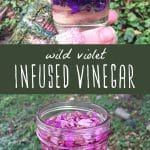
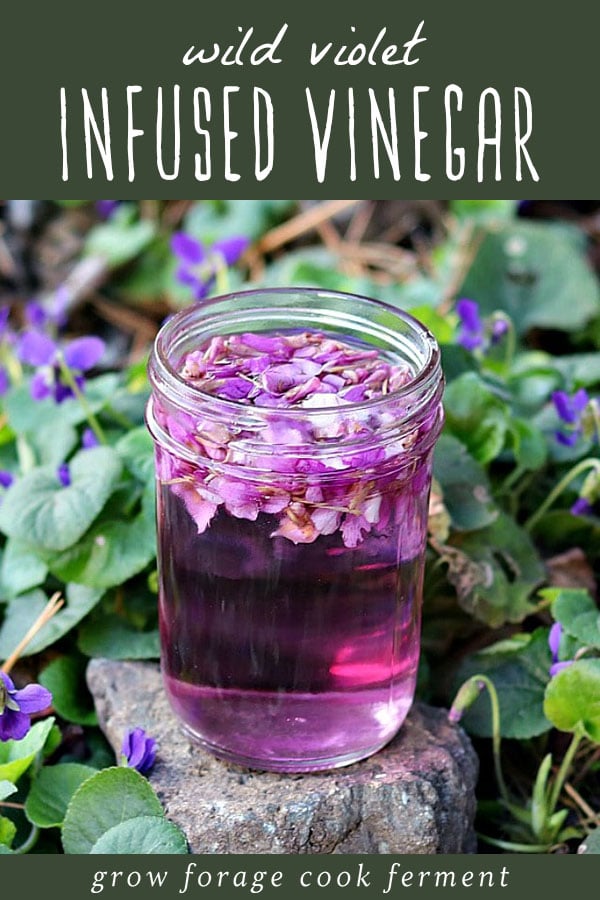
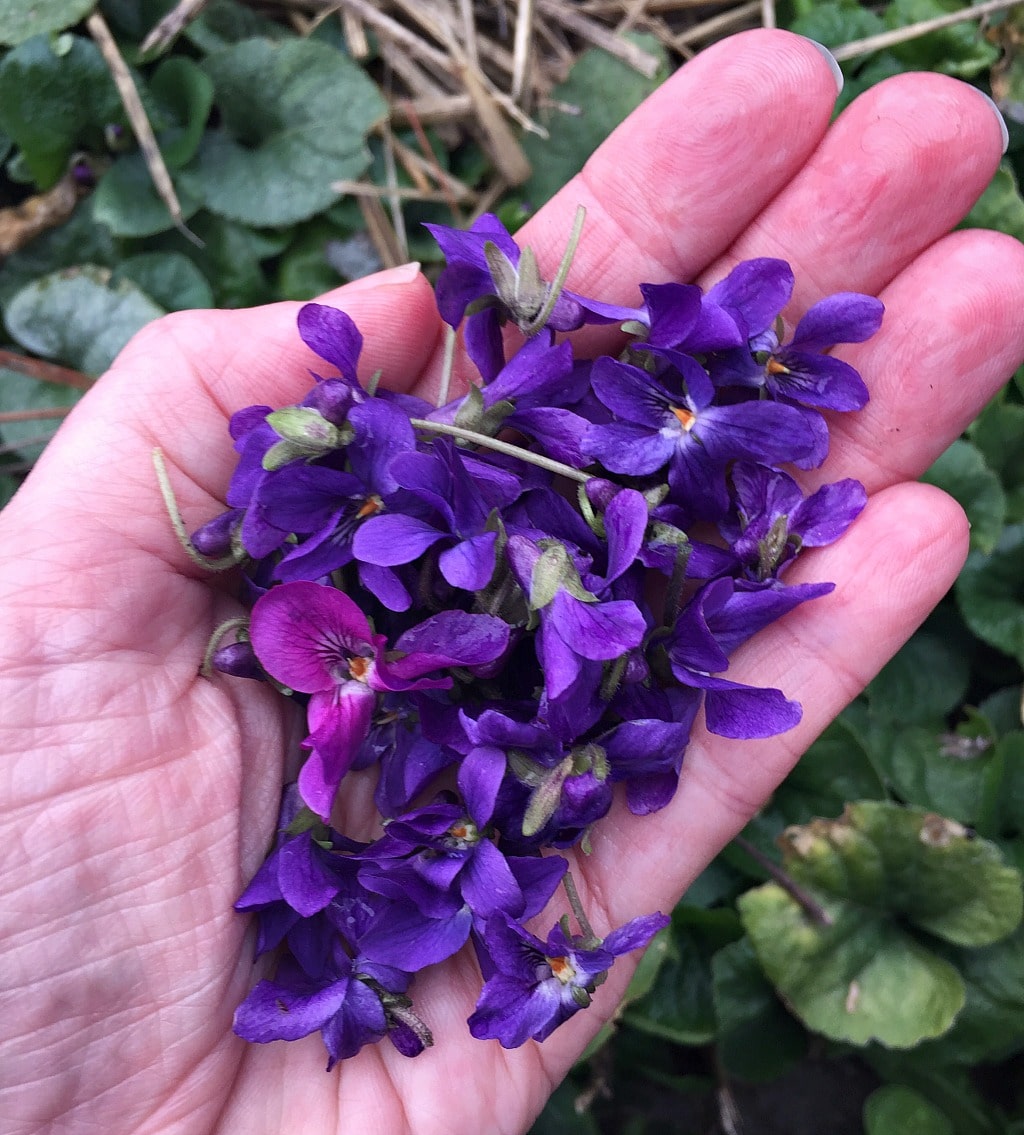
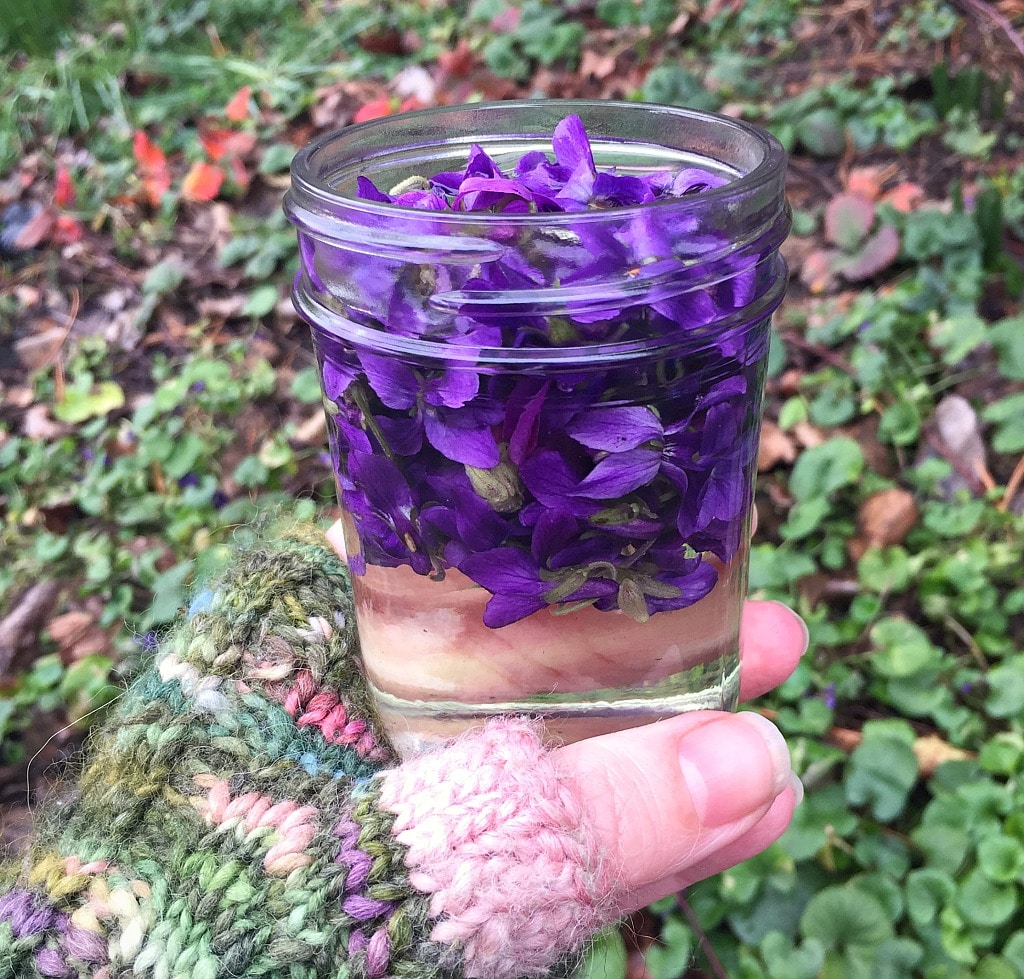
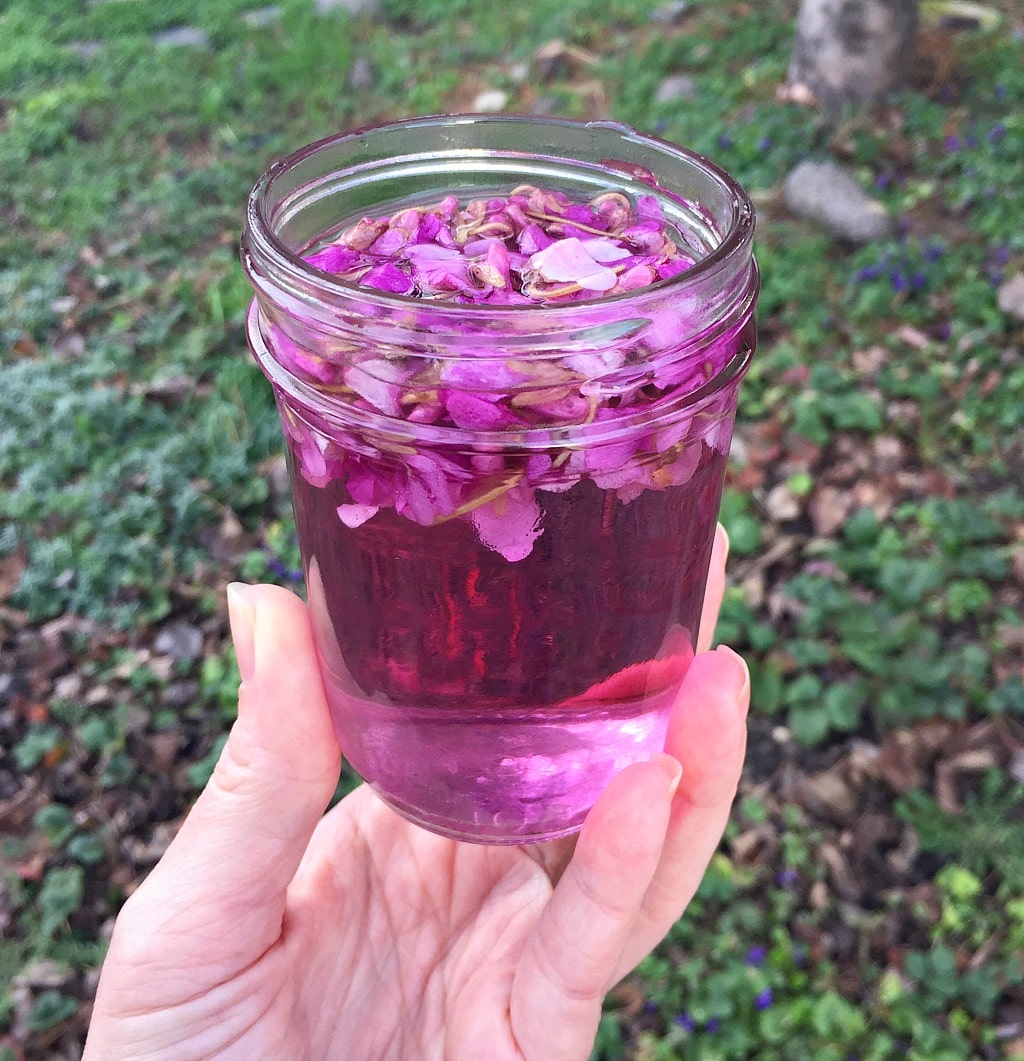
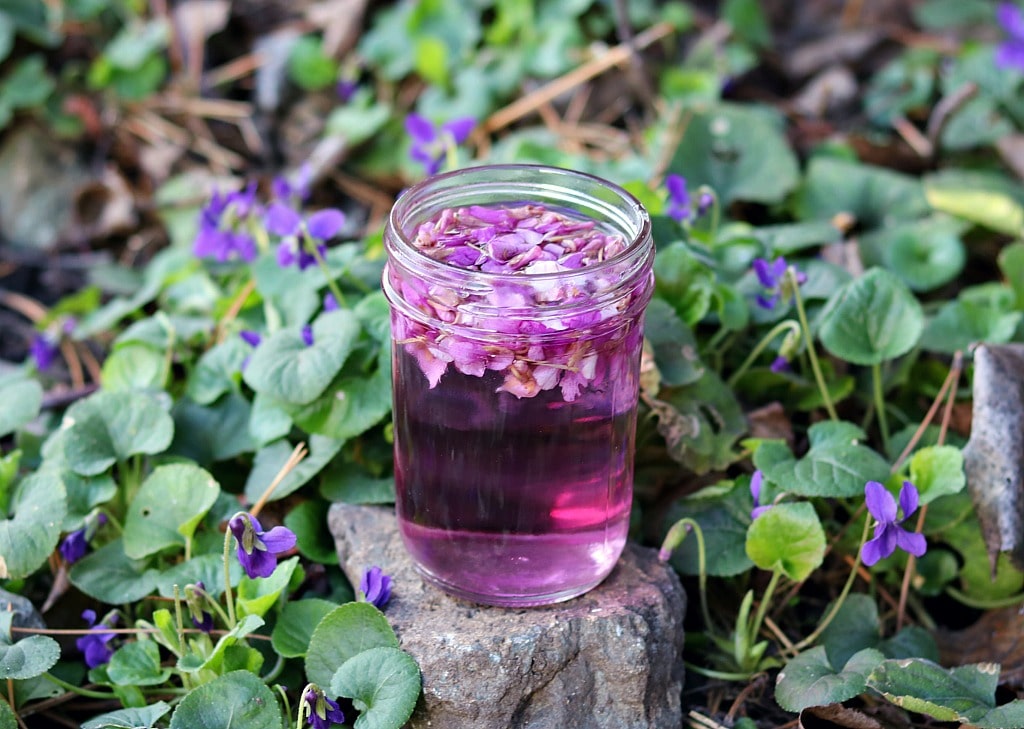
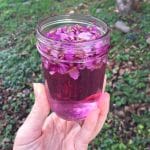

Can one use English violets for this??
Question: Could you make a violet tincture with alcohol?
Has anyone use this to make an astringent or other skin products?
It seems like infused violet vinegar would make a great soothing, cooling spray. Would you add distilled water to the spray bottle, then pour in the vinegar (to diminish the vinegar smell)?
NEVER put cooking vinegar on your face!! The level of acidity ( vinegar is acetic acid!) can burn you and would certainly cause your eyes to tear & burn; if you got in in your eyes, that’s an ER situation. Use instead Witch Hazel to make a Violet-Infused facial spray. After it’s infused, keep it in the fridge to have a cooling, soothing treat for your face in hot weather . With Hazel has some modest antimicrobial & antiviral properties and is also a mild astringent, so is good for your skin, esp if oily or combination.
Do you think it matters which species one uses? I know there are very many types of Violet, and people usually just talk about the “Sweet Violet” which has the famous yummy scent.
I am new to the Pine Woods region of Texas and just learned that wild violets grow here and have sprung up around the base of the pines. But they don’t have much of a scent, and their leaves are a little smaller than the usual iconic larger heart-shaped ones. I couldn’t say what kind they are but I know they are a type of wild violet. They have great color and look mostly like yours, apart from the leaves.
Do you think they need to be the strongly aromatic type to be worth using?
No, they don’t have to be “strongly aromatic”. Most wild Violet species have a subtle scent. You can use any Wild Violet but never African Violets, which don’t grow wild anyway. The subtleness of the scent is lovely, which is why I use a Champagne or Prosecco Vinegar to make my Wild Violet Vinegar, so the smell of the vinegar doesn’t eradicate the Violets~
Awesome,! Does it have a shelf life,? .
Since it is vinegar it will last for quite a while, but it does tend to lose it’s vibrant color after a few months.
*HINT* If you want to keep that lovely color, when it begins to fade you can add just a teensy weensy speck of Wilton’s Violet Paste food color to your vinegar jar, will restore the color, is absolutely food safe. It can be your dirty little pantry secret, LOL. You don’t have to do this, of course, just a suggestion to help you maintain the beautiful color. Cheers~
I need to send a lot of your articles to my neighbors to let them know…The plants in my yard are not Weeds to be sprayed and killed. Maybe then they will leave me alone and quit complaining about my way of living. I know what goes into my products, because I make them, not some company with labels of ingredients which you cannot even read or say.
My violet collection in my yard averages 3-4 loosely packed bushel baskets. They thrive along with the dandelions. Love my yard.
I find white vinegar to be very harsh. Would ACV work as well? Or maybe rice vinegar?
Yes you can use any vinegar that you prefer. I like using white balsamic for this recipe!
Wow! I love the colour! I have some violets growing so I will try this.
Hello, I was just wondering if you are supposed to strain out the spent violets after it has infused?
My friend who does this says sometimes she does and sometimes she doesn’t. Just depends upon how she’s using it at the time. She also adds a few dandelion petals to hers sometimes.